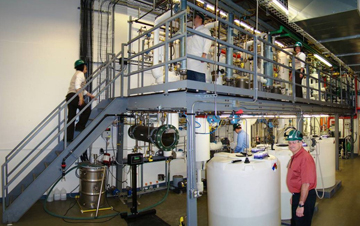 Segetis recently announced that Minnesota’s Department of Agriculture has awarded the company $325,000 in NextGen Energy grant funding through the state’s Agricultural Growth, Research and Innovation (AGRI) program. In April, Segetis also received $21.2 million in funding from the Iron Range Resources and Rehabilitation Board (IRRRB), a state economic development agency based in northeastern Minnesota.
Segetis recently announced that Minnesota’s Department of Agriculture has awarded the company $325,000 in NextGen Energy grant funding through the state’s Agricultural Growth, Research and Innovation (AGRI) program. In April, Segetis also received $21.2 million in funding from the Iron Range Resources and Rehabilitation Board (IRRRB), a state economic development agency based in northeastern Minnesota.
Not much information was written in the latest press release although according to this article from Biomass magazine, the funding will be used for equipment, capital construction and materials for operation of the company’s pilot plant located in Golden Valley, Minnesota, which will be used to optimize process development required to commercialized its levulinic ketal-based plasticizer.
Segetis is reportedly planning a commercial plant in Laskin Energy Park in Hoyt Lakes, Minnesota, that will produce levulinic acid and convert a portion of that output into plasticizer. The initial facility is expected to have annual levulinic acid production capacity of 22 million pounds, with around 35 million pounds of plasticizer production capacity.
I have yet to talk to Segetis and will do so soon to get updates on this proposed commercial facility. The last time that the blog interviewed the company, Segetis said it is sourcing its levulinic acid from China. There are not many levulinic acid production worldwide because the process, which uses lignocellulosic feedstock, is reportedly expensive and maximum theoretical yields are low (64% yield by weight from hexoses and 71% yield from cellulose). Some of the published studies claimed levulinic acid yields of up to about 2/3 of the theoretical yields, mostly because of formation of by-products in the fermentation reactor.
According to Biomass magazine, the construction of Segetis’ commercial plant could begin as soon as this fall depending on how long it takes to secure the necessary permits and financing. It is estimated that the plant will take around 18 months to build. The second phase of the project will include capacity expansion plans of five times the original output. Another source reported that total project investment for the commercial-scale plant is $105 million, 70% of which will be funded by Segetis.
Levulinic acid is considered by the US Department of Energy as one of the top 12 biomass-based chemical building blocks. However, it seems that there are not that many companies that are directly developing this space.
The Netherlands-based Avantium noted that the company’s YXY technology platform also included methyl levulinate, an intermediate that can be further converted into levulinic acid.
Switzerland-based AVA Biochem is currently producing 5-hydroxymethylfurfural (5-HMF), and this building block can also serve as an intermediate to produce levulinic acid via rehydration of HMF with formic acid as co-product.
In the US, it was reported that BioFine Technology LLC has the capability at its Gorham, Maine, pilot facility to produce 600 pounds/day of levulinic acid from one ton of dry biomass (ex. paper mill sludge) per day. The company, however, seems to be focusing more on producing levulinate esters as fuel additives.




